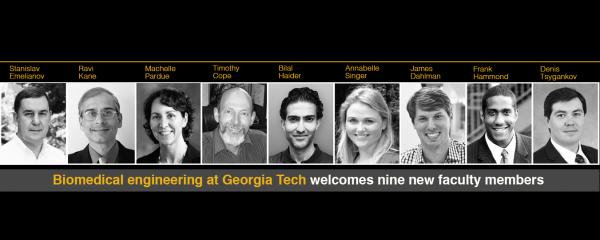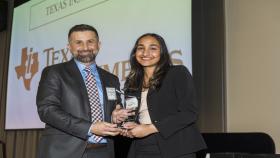For the 2015-2016 academic year, nine new faculty have joined Georgia Tech and the Wallace H. Coulter Department of Biomedical Engineering. Please welcome the following faculty:
Stanislav Emelianov
Joseph M. Pettit Chair in Microelectronics and Georgia Research Alliance Eminent Scholar, joint appointment with the School of Electrical and Computer Engineering
Ph.D., Moscow State University
Postdoctoral Fellow, University of Michigan
Area of focus: Imaging and Cancer Technologies
Stanislav Emelianov received his Ph.D. degree from Moscow State University, Russia. He was previously professor of biomedical engineering at The University of Texas at Austin, and an adjunct professor of imaging physics at the M.D. Anderson Cancer Center. Emelianov’s research interests are in the areas of intelligent diagnostic imaging and patient-specific image-guided therapeutics including cancer imaging and diagnosis, the detection and treatment of atherosclerosis, the development of imaging and therapeutic nanoagents, guided drug delivery and controlled release, simultaneous anatomical, functional, cellular and molecular imaging, multi-modal imaging, and image-guided therapy.
----------
Ravi Kane
Garry Betty Chair and Georgia Research Alliance Eminent Scholar in Cancer Nanotechnology, School of Chemical & Biomolecular Engineering
Ph.D., Massachusetts Institute of Technology
Postdoctoral Fellow, Harvard University
Area of focus: Nanotechnology
Ravi Kane went to graduate school at MIT where he received a Ph.D. in chemical engineering. Kane’s research lies at the interface of biotechnology and nanotechnology. His group is designing nanoscale polyvalent therapeutics and working on the molecular engineering of biosurfaces and nanostructures. Kane was previously named by MIT’s Technology Review as one of the TR100 – the top 100 young innovators in the world. After postdoctoral research at Harvard University, Kane joined Rensselaer Polytechnic Institute eventually becoming head of the Department of Chemical and Biological Engineering.
----------
Machelle Pardue
Professor
Ph.D., University of Waterloo
Postdoctoral Fellow, Loyola University
Area of focus: Neuroengineering
Machelle Pardue is also a research career scientist at the Atlanta VA Medical Center, and an associate professor in the Department of Ophthalmology at Emory University School of Medicine. Pardue received her Ph.D. in vision science and biology at the University of Waterloo. Her research has been continuously supported by the Department of Veterans Affairs, NIH, and private companies. Pardue’s laboratory uses a combination of electrophysiological, histological, imaging, and molecular techniques to investigate the pathophysiology of retinal disease and develop treatments and therapies to preserve or restore vision. Her current research focuses on retinal degenerations, diabetic retinopathy, and myopia.
----------
Timothy Cope
Professor, joint appointment with the School of Applied Physiology
Ph.D., Duke University
Postdoctoral Fellow, University of Washington
Area of focus: Neuroengineering
Timothy Cope’s research interests center on control of movement by sensorimotor integration in the mammalian spinal cord. Using predominantly electrophysiological methods applied in vivo, his group studies neural signaling by spinal motoneurons, somatosensory neurons, and their central synapses. Their primary analyses include electrical properties, synaptic function, and firing behavior of single neurons. His group is actively examining how these neurons and synapses respond soon and long after peripheral nerve injury and regeneration. Recent findings demonstrate that successful regeneration of damaged sensory axons does not prevent complex reorganization of their synaptic connections made within the spinal cord. He also continues to explore fundamental operations of the normal adult nervous system.
----------
Bilal Haider
Assistant Professor
Ph.D., Yale University
Postdoctoral Fellow, University College London
Area of focus: Neuroengineering
Bilal Haider’s research goal is to identify cellular and circuit mechanisms that modulate neuronal responsiveness in the cerebral cortex in vivo.
He has identified excitatory and inhibitory mechanisms in vivo that mediate rapid initiation, sustenance, and termination of persistent activity in the cortex. He is investigating the role of inhibitory circuits during wakefulness. His work showed for the first time that synaptic inhibition powerfully controls the spatial and temporal properties of visual processing in the awake cortex. His future research will investigate mechanisms used by excitatory and inhibitory neuronal sub-types in the cortex during goal-directed behaviors.
----------
Annabelle Singer
Assistant Professor
Ph.D., University of California San Francisco
Postdoctoral Fellow, Massachusetts Institute of Technology
Area of focus: Neuroengineering
For a hundred years, scientists have investigated neural codes, patterns of neural spiking activity from single to hundreds of cells, to try to understand how this activity represents experiences. Annabelle Singer’s research elucidates how such neural activity is decoded at multiple levels: from downstream cells receiving this activity via synaptic inputs to the behavior driven by such activity. To do this she uses a combination of novel electrophysiological, behavioral, optogenetic, and computational tools to determine how neural activity is received and interpreted by downstream cells in awake behaving animals and how neural activity drives behavior.
----------
James Dahlman
Assistant Professor
Ph.D., Massachusetts Institute of Technology
Postdoctoral Fellow, Broad Institute of MIT and Harvard
Area of focus: Drug Delivery and Cardiovascular Engineering
James Dahlman is a chemical and bioengineer whose work lies at the interface of nanotechnology, genomics, and gene editing. He studied in vivo gene editing at the Broad Institute of Harvard and MIT; he received his Ph.D. from MIT and Harvard Medical School. Dahlman is interested in drug delivery, targeted in vivo gene editing, and using genomics to improve biomaterial design. He has designed and synthesized nanoparticles that efficiently deliver RNAs to the lung and heart. These nanoparticles can deliver multiple RNAs at once, and can simultaneously knockdown five genes concurrently in vivo. They have been used by over ten labs across the United States to study cancer, atherosclerosis, inflammation, emphysema, and pulmonary hypertension, and are being evaluated for clinical trials.
----------
Frank L. Hammond III
Assistant Professor, joint appointment with the Woodruff School of Mechanical Engineering
Ph.D., Carnegie Mellon University
Postdoctoral Fellow, Harvard University and Massachusetts Institute of Technology
Area of focus: Healthcare Robotics
Frank Hammond has dedicated much of his academic career to conducting research as a mechanical engineer and roboticist. A vast majority of that time has been spent at the intersection of robotics and healthcare. His research efforts are centered on the development of adaptive robotic manipulation systems: robotic devices having morphological structures, actuation topologies, and sensing and control schemes that make them well-suited to operating alongside or in the place of humans in unstructured, dynamically varying environments. Adaptive robotic devices have several promising, clinically-relevant applications and have demonstrated the potential to improve standards of care and patient accessibility to treatments in areas such as teleoperative microsurgery and at-home physical therapy.
----------
Denis Tsygankov
Assistant Professor
Ph.D., Georgia Institute of Technology
Postdoctoral Fellow, University of North Carolina
Area of focus: Mechanics and Systems Biology
Denis Tsygankov obtained his Ph.D. from the Georgia Institute of Technology where his research interests were on synchronization phenomena in coupled dynamical systems. As a postdoctoral fellow at the University of Maryland, College Park, Tsygankov applied his knowledge of theoretical physics to study biological systems. His research during this time focused on energy transduction and force degeneration by molecular motors, such as kinesin and dynein. His current research is focused on developing and applying computational methods, including mathematical modeling, simulations, and computer vision approaches to understand complex multi-scale physiological processes including vasculogenesis, morphogenesis, and wound healing.
Contact:
Walter Rich
Communications Manager
Wallace H. Coulter Department of Biomedical Engineering
Georgia Institute of Technology
Media Contact
Communications Manager
Wallace H. Coulter Department of Biomedical Engineering
Georgia Institute of Technology
Keywords
Latest BME News
Jo honored for his impact on science and mentorship
The department rises to the top in biomedical engineering programs for undergraduate education.
Commercialization program in Coulter BME announces project teams who will receive support to get their research to market.
Courses in the Wallace H. Coulter Department of Biomedical Engineering are being reformatted to incorporate AI and machine learning so students are prepared for a data-driven biotech sector.
Influenced by her mother's journey in engineering, Sriya Surapaneni hopes to inspire other young women in the field.
Coulter BME Professor Earns Tenure, Eyes Future of Innovation in Health and Medicine
The grant will fund the development of cutting-edge technology that could detect colorectal cancer through a simple breath test
The surgical support device landed Coulter BME its 4th consecutive win for the College of Engineering competition.








